
Schutztruppe
Encyclopedia
Schutztruppe was the African colonial
armed force
of Imperial Germany from the late 19th century to 1918, when Germany lost its colonies. Similar to other colonial forces, the Schutztruppe consisted of volunteer European commissioned and non-commissioned officers, medical and veterinary officers. Most enlisted ranks were generally recruited locally. In German East Africa
they became famous as Askari
. Police
forces also were established in the colonies. Control of the German colonies of New Guinea
(including the Bismarck Archipelago and North Pacific islands) and in German Samoa
was performed by small local police detachments. Kiautschou
in China was under naval administration.
The colonial force for German East Africa was established by an act of the Reichstag
on 22 March 1891; the colonial forces for German West Africa and German Southwest Africa on 9 June 1895. Schutztruppe formations were organizationally never a part of the army or navy. In 1896 Schutztruppe headquarters was established and located at Berlin’s Mauerstrasse, in proximity to the German Colonial Office
. German military law and discipline applied to the Schutztruppe.
In 1914 there were three Schutztruppe commands, one in each of the German colonial regions in East, West, and Southwest Africa.
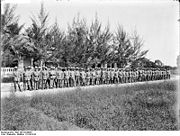
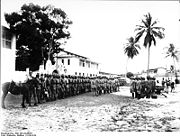
 At the outbreak of World War I, the Schutztruppe in German East Africa
At the outbreak of World War I, the Schutztruppe in German East Africa
was organized into 14 field companies [Feldkompanien] with 2,500 men under arms, with headquarters at the capital Dar es Salaam
. Including carriers and laborers, the force totaled approximately 14,000 personnel. On 13 April 1914, Lieutenant Colonel Paul Emil von Lettow-Vorbeck
assumed command in German East Africa. He led his units throughout World War I, eventually being promoted to Generalmajor. The Schutztruppe in East Africa became the last German formation to surrender – days after the armistice in November 1918.
A pre-war company consisted of 160 (expandable to 200) men in three platoons [Züge] of 50 to 60 men each, including two machine gun teams. Each of the 14 companies also had a minimum 250 man carrier contingent as well as native irregulars known as Ruga-Ruga.
The Dar es Salaam garrison further included a recruitment depot, a signals department and quartermaster unit.
Overall strength was 300 European recruits and 2,472 Africans, specifically 68 combatant officers, 60 warrant officers and NCOs
, 132 non-combatant medical officers, civilian administrators, ammunition technicians, and 2 African officers and 184 African NCOs and 2,286 Askaris.
During the Great War
, companies numbered 15 through 30 were added, plus A through H temporary companies; and 1st through 8th Schützenkompagnies [rifle companies]. The Schützenkompagnies were originally composed of white settlers, their sons, plantations administrators and trading company employees, i.e., colonial volunteers, but some units became racially mixed as the war dragged on. Numerous other small detachments were also formed.
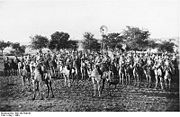
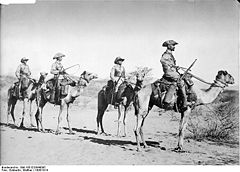 The Schutztruppe in German Southwest Africa was structured in 12 companies of mounted infantry totalling 1,500 men, primarily Germans. The 7th Company, stationed in the northern desert area of the colony, was mounted on imported camels. A single unit, called the Baster
The Schutztruppe in German Southwest Africa was structured in 12 companies of mounted infantry totalling 1,500 men, primarily Germans. The 7th Company, stationed in the northern desert area of the colony, was mounted on imported camels. A single unit, called the Baster
Company of non-local Africans was raised and deployed. Relations between the German administration and the natives in this colony had deteriorated to the point that few local Africans were recruited; however, Boers and Afrikaners did join to renew their fight against Great Britain
.
The colonial forces for German Southwest Africa consisted of volunteers from the imperial army and navy (including some Austrians), but essentially consisted of members of German regiments. Before their deployment to Africa these troops were prepared for their special tasks and future environment. Such a training base was at Karlsruhe
. Because of the often humid conditions in the upper Rhine valley of the grand-duchy of Baden, the area provided some early acclimatization.
The structure of the Southwest African forces was as follows:
German Southwest Africa Command at Windhuk (modern Windhoek) consisted of headquarters, administration and legal (judge advocate), medical corps, surveying and mapping units.
Northern district command: Windhuk
Southern district command: Keetmanshoop
At the outbreak of World War I the force had a total strength of 91 officers, 22 physicians, 9 veterinarians, 59 civilian administrators, ammunition technicians, 342 NCOs and 1,444 German other ranks for a total of 1,967 personnel.
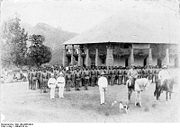 German West Africa encompassed two colonial entities, Kamerun
German West Africa encompassed two colonial entities, Kamerun
and Togoland
.
The Kamerun force in 1914 consisted of 12 companies, totaling 1,600 men with headquarters at Soppo
and established in 1894 from the existing police force (formed in 1891).
The structure of the Kamerun forces was as follows:
Central Command: Soppo near the capital Buea
The companies were assigned to 49 garrisons in Kamerun and consisted of 61 officers, 23 physicians, 23 civilian administrators, ammunition technicians, 98 German NCOs and 1,650 African enlisted ranks for a total personnel count of 1,855.
Togoland had a total police force of 673 personnel deployed throughout the colony. Approximately 1,000 troops were raised after the outbreak of World War I. With few arms, ammunition or provisions, by the end of August 1914, all were forced to surrender to invading French and British forces.
German language sites:
Colony
In politics and history, a colony is a territory under the immediate political control of a state. For colonies in antiquity, city-states would often found their own colonies. Some colonies were historically countries, while others were territories without definite statehood from their inception....
armed force
Army
An army An army An army (from Latin arma "arms, weapons" via Old French armée, "armed" (feminine), in the broadest sense, is the land-based military of a nation or state. It may also include other branches of the military such as the air force via means of aviation corps...
of Imperial Germany from the late 19th century to 1918, when Germany lost its colonies. Similar to other colonial forces, the Schutztruppe consisted of volunteer European commissioned and non-commissioned officers, medical and veterinary officers. Most enlisted ranks were generally recruited locally. In German East Africa
German East Africa
German East Africa was a German colony in East Africa, which included what are now :Burundi, :Rwanda and Tanganyika . Its area was , nearly three times the size of Germany today....
they became famous as Askari
Askari
Askari is an Arabic, Bosnian, Urdu, Turkish, Somali, Persian, Amharic and Swahili word meaning "soldier" . It was normally used to describe local troops in East Africa, Northeast Africa, and Central Africa serving in the armies of European colonial powers...
. Police
Police
The police is a personification of the state designated to put in practice the enforced law, protect property and reduce civil disorder in civilian matters. Their powers include the legitimized use of force...
forces also were established in the colonies. Control of the German colonies of New Guinea
German New Guinea
German New Guinea was the first part of the German colonial empire. It was a protectorate from 1884 until 1914 when it fell to Australia following the outbreak of the First World War. It consisted of the northeastern part of New Guinea and several nearby island groups...
(including the Bismarck Archipelago and North Pacific islands) and in German Samoa
German Samoa
German Samoa was a German protectorate from 1900 to 1914, consisting of the islands of Upolu, Savai'i, Apolima and Manono, now wholly within the independent state Samoa, formerly Western Samoa...
was performed by small local police detachments. Kiautschou
Jiaozhou Bay concession
The Kiautschou Bay concession was a German colonial concession in Imperial China which existed from 1898 to 1914. It had an area of 552 km², it was located around Jiaozhou Bay on the southern coast of the Shandong Peninsula, which lay in the imperial province of Shandong in northern China.Jiaozhou...
in China was under naval administration.
The colonial force for German East Africa was established by an act of the Reichstag
Reichstag (German Empire)
The Reichstag was the parliament of the North German Confederation , and of the German Reich ....
on 22 March 1891; the colonial forces for German West Africa and German Southwest Africa on 9 June 1895. Schutztruppe formations were organizationally never a part of the army or navy. In 1896 Schutztruppe headquarters was established and located at Berlin’s Mauerstrasse, in proximity to the German Colonial Office
Reichskolonialamt
The Imperial Colonial Office was the German governmental agency tasked with managing Germany's overseas protectorates or colonies. After the First World War, on 20 February 1919, the Imperial Colonial Ministry replaced the Imperial Colonial Office...
. German military law and discipline applied to the Schutztruppe.
In 1914 there were three Schutztruppe commands, one in each of the German colonial regions in East, West, and Southwest Africa.
German East Africa
- See also East African Campaign (World War I)East African Campaign (World War I)The East African Campaign was a series of battles and guerrilla actions which started in German East Africa and ultimately affected portions of Mozambique, Northern Rhodesia, British East Africa, Uganda, and the Belgian Congo. The campaign was effectively ended in November 1917...



German East Africa
German East Africa was a German colony in East Africa, which included what are now :Burundi, :Rwanda and Tanganyika . Its area was , nearly three times the size of Germany today....
was organized into 14 field companies [Feldkompanien] with 2,500 men under arms, with headquarters at the capital Dar es Salaam
Dar es Salaam
Dar es Salaam , formerly Mzizima, is the largest city in Tanzania. It is also the country's richest city and a regionally important economic centre. Dar es Salaam is actually an administrative province within Tanzania, and consists of three local government areas or administrative districts: ...
. Including carriers and laborers, the force totaled approximately 14,000 personnel. On 13 April 1914, Lieutenant Colonel Paul Emil von Lettow-Vorbeck
Paul Emil von Lettow-Vorbeck
Paul Emil von Lettow-Vorbeck was a general in the Imperial German Army and the commander of the German East Africa campaign. For four years, with a force that never exceeded about 14,000 , he held in check a much larger force of 300,000 British, Belgian, and Portuguese troops...
assumed command in German East Africa. He led his units throughout World War I, eventually being promoted to Generalmajor. The Schutztruppe in East Africa became the last German formation to surrender – days after the armistice in November 1918.
A pre-war company consisted of 160 (expandable to 200) men in three platoons [Züge] of 50 to 60 men each, including two machine gun teams. Each of the 14 companies also had a minimum 250 man carrier contingent as well as native irregulars known as Ruga-Ruga.
- 1st Company [Kompanie]: Arusha/Neu Moshi
- 2nd Company: Iringa and Unbena
- 3rd Company: Lindi
- 4th Company: Kilimatinde and Singida
- 5th Company: Massoko
- 6th Company: Udjidiji and Kassulo
- 7th Company: Bukoba, Ussuwi and Kifumbiro
- 8th Company: Tabora
- 9th Company: Usumbura
- 10th Company: Dar es Salaam
- 11th Company: Kissenji and Mruhengeri
- 12th Company: Mahenge
- 13th Company: Kondoa Irangi
- 14th Company: Muansa and Ikoma
The Dar es Salaam garrison further included a recruitment depot, a signals department and quartermaster unit.
Overall strength was 300 European recruits and 2,472 Africans, specifically 68 combatant officers, 60 warrant officers and NCOs
NCOS
NCOS was the graphical user interface-based operating system developed for use in Oracle's Network Computers. It was adapted by Acorn Computers from its own , which was originally developed for their range of Archimedes desktop computers...
, 132 non-combatant medical officers, civilian administrators, ammunition technicians, and 2 African officers and 184 African NCOs and 2,286 Askaris.
During the Great War
World War I
World War I , which was predominantly called the World War or the Great War from its occurrence until 1939, and the First World War or World War I thereafter, was a major war centred in Europe that began on 28 July 1914 and lasted until 11 November 1918...
, companies numbered 15 through 30 were added, plus A through H temporary companies; and 1st through 8th Schützenkompagnies [rifle companies]. The Schützenkompagnies were originally composed of white settlers, their sons, plantations administrators and trading company employees, i.e., colonial volunteers, but some units became racially mixed as the war dragged on. Numerous other small detachments were also formed.
German Southwest Africa


Baster
The Basters are the descendants of Cape Colony Dutch and indigenous African women. They largely live in Namibia and are similar to Coloured or Griqua people in South Africa....
Company of non-local Africans was raised and deployed. Relations between the German administration and the natives in this colony had deteriorated to the point that few local Africans were recruited; however, Boers and Afrikaners did join to renew their fight against Great Britain
Great Britain
Great Britain or Britain is an island situated to the northwest of Continental Europe. It is the ninth largest island in the world, and the largest European island, as well as the largest of the British Isles...
.
The colonial forces for German Southwest Africa consisted of volunteers from the imperial army and navy (including some Austrians), but essentially consisted of members of German regiments. Before their deployment to Africa these troops were prepared for their special tasks and future environment. Such a training base was at Karlsruhe
Karlsruhe
The City of Karlsruhe is a city in the southwest of Germany, in the state of Baden-Württemberg, located near the French-German border.Karlsruhe was founded in 1715 as Karlsruhe Palace, when Germany was a series of principalities and city states...
. Because of the often humid conditions in the upper Rhine valley of the grand-duchy of Baden, the area provided some early acclimatization.
The structure of the Southwest African forces was as follows:
German Southwest Africa Command at Windhuk (modern Windhoek) consisted of headquarters, administration and legal (judge advocate), medical corps, surveying and mapping units.
Northern district command: Windhuk
- 1st Company: Regenstein, SeeisSeeisSeeis [ˈseːaɪs] is a small settlement in the Khomas Region of central Namibia. It is situated on the B6 national road east of Hosea Kutako International Airport on the turnoff of the dirt road D1458. The Seeis Rivier, an ephemeral river, cuts the settlement...
- 4th Company: Okanjande
- 6th Company: Outjo and Otavi
- 2nd Battery: Johann-Albrechts-Höhe
- Transport platoon 1: Karibib
- Office for provisions: Karibib
- Horse depot: Okawayo
- Artillery and train depot: Windhuk
- Military hospital and medical depot: Windhuk
- Clothing depot: Windhuk
- Local headquarters: Windhuk
- Local headquarters and quartermaster: Swakopmund
Southern district command: Keetmanshoop
- 2nd Company: Ukamas
- 3rd Company: Kanus
- 5th Company: Chamis and Churutabis
- 7th and 8th Company (camel cavalry), military hospital: Gochas and Arahoab
- 1st Battery: Narubis
- 3rd Battery: Gibeon
- Transport platoon 2: Keetmanshoop
- Artillery and train depot: Keetmanshoop
- Military hospital and medical depot: Keetmanshoop
- Clothing depot: Keetmanshoop
- Office for provisions: Keetmanshoop
- Garrison administration: Keetmanshoop
- Horse depot: Aus
- Camel stud farm: Kalkfontain
- Local headquarters and quartermaster: Lüderitz
At the outbreak of World War I the force had a total strength of 91 officers, 22 physicians, 9 veterinarians, 59 civilian administrators, ammunition technicians, 342 NCOs and 1,444 German other ranks for a total of 1,967 personnel.
German West Africa

Kamerun
German Cameroon was a West African colony of the German Empire from 1884 to 1916 in the region of today's Republic of Cameroon.-History:-1800s:...
and Togoland
Togoland
Togoland was a German protectorate in West Africa from 1884 to 1914, encompassing what is now the nation of Togo and most of what is now the Volta Region of Ghana. The colony was established during the period generally known as the "Scramble for Africa"...
.
The Kamerun force in 1914 consisted of 12 companies, totaling 1,600 men with headquarters at Soppo
Soppo
Soppo is the name of two villages, Great Soppo and Small Soppo in Buea, western Cameroon. It is located at around .From 1904 to 1914 it was the headquarters of the German colonial military forces...
and established in 1894 from the existing police force (formed in 1891).
The structure of the Kamerun forces was as follows:
Central Command: Soppo near the capital Buea
- 1st Company (headquarters company) and artillery detachment: Duala
- 2nd Company: Bamenda, Wum and Kentu
- 3rd Company: Mora and Kusseri
- 4th Company: (expedition/survey company): Soppo
- 5th Company: Buar, Carnot and Ebolowa
- 6th Company: Mbaiki, Nola and Nguku
- 7th Company: Garua, Marua, Mubi
- 8th Company: Ngaundere
- 9th Company: Dume and Baturi
- 10th Company: Ojem and Mimwoul
- 11th Company: Akoafim and Minkebe
- 12th Company: Bumo, Fianga, and Gore
The companies were assigned to 49 garrisons in Kamerun and consisted of 61 officers, 23 physicians, 23 civilian administrators, ammunition technicians, 98 German NCOs and 1,650 African enlisted ranks for a total personnel count of 1,855.
Togoland had a total police force of 673 personnel deployed throughout the colony. Approximately 1,000 troops were raised after the outbreak of World War I. With few arms, ammunition or provisions, by the end of August 1914, all were forced to surrender to invading French and British forces.
Literature
- German Colonial Encyclopaedia, 1920, Volume III, p. 321ff.
- Kopf, Werner. The German colonial force 1889/1918, Dörfler Publishing House
- Morlang, Thomas. Askari und Fitafita. Farbige Söldner in den deutsche Kolonien. Berlin 2008
- Reith, Wolfgang. The Command Authorities of the Imperial Colonial Force in the Homeland. German Soldier Yearbook 2000 and 2001 (2 parts). Munich: Signal Publishing House.
External links
German language sites:
- Protection and Overseas Troops
- Mauerstraße 45/46: The Oberkommando der Schutztruppen (Africa in Berlin - German History MuseumDeutsches Historisches MuseumThe German Historical Museum , DHM for short, is a museum in Berlin devoted to German history and defines itself as a place of enlightenment and understanding of the shared history of Germans and Europeans....
)

